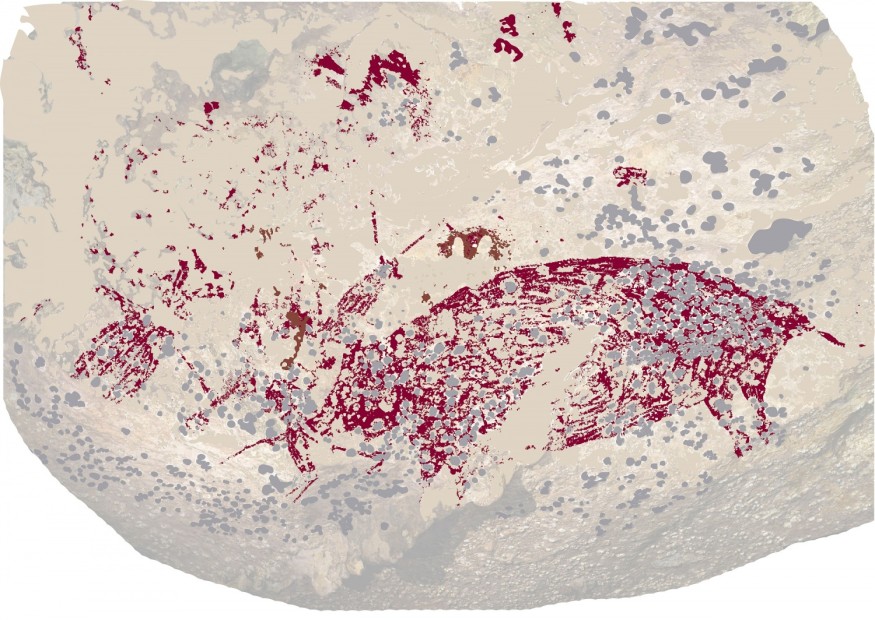Sulawesi Cave Paintings Revealed As World’s Oldest Figurative Art at 57,000 Years

Over 50,000 years ago, the people who lived in the verdant valleys of Sulawesi Island ascended to the small limestone caverns above their dwellings. Inspired by their lives, they painted fanciful scenes in these isolated areas, featuring purple and red, half-animal, half-human figures hunting pigs.
Discovery of the Oldest Known Visual Story
A recent paper published in Nature by archaeologists from Indonesia and Australia reveals that these scenes represent the world's oldest known 'picture story,' created at least 57,000 years ago. This discovery predates the paintings in a nearby cave, dated by the same team in 2021, by 5,700 years. Additionally, these dates place the Sulawesi paintings 15,000 years before the famous cave paintings in Europe.
The newly dated artwork, found inside a limestone hollow called Leang Karampuang on Sulawesi, depicts what appears to be a Sulawesi warty pig surrounded by smaller figures resembling humans or human-animal hybrids. Over millennia, atmospheric conditions left whitish lumps of calcium carbonate, known as "cave popcorn," on the paintings. In 2021, the team sampled chunks of this "popcorn" from a painting in a nearby cave called Leang Bulu Sipong 4, yielding an average date of 41,900 B.C.E. However, this date included outer, and therefore younger, layers of the popcorn.
New Techniques
For the new study, researchers, including archaeologist Adhi Agus Oktaviana and colleagues from the Indonesian National Research and Innovation Agency (BRIN), used a laser to remove layers of calcium carbonate less than 50 microns thick in both caves. This technique allowed them to target the popcorn layers just above the pigment, which were laid down shortly after the art was created. By dating infinitesimal amounts of uranium in the mineral layer formed just above the pigment, the authors demonstrated that the Leang Karampuang cave artwork is at least 51,200 years old, painted not long after humans expanded east out of Africa into Asia and the island chains of Oceania. They also redated the artwork in Leang Bulu Sipong 4, finding it to be 48,000 years old, 4,000 years older than previously thought.
Archaeological evidence suggests the Sulawesi paintings had deep ritual or educational significance for the people who created them. Hundreds of rock art panels made using ocher pigment have been documented in the region. These paintings are often found in small caves high above the valleys where mobile hunter-gatherers roamed. They likely climbed into these high-level caves specifically to create or view rock art, marking these locations as special places in the landscape.
Comparing Ancient Art
While older cave art exists, consisting of simple shapes such as geometric incisions on ocher chunks at Blombos Cave in South Africa, the Sulawesi paintings are the oldest depicting figures of humans and animals in a narrative form. Another Indonesian island was home to the diminutive, small-brained "hobbit" species when these paintings were made. However, the sophistication of Sulawesi's paintings suggests modern humans produced them.
Caves in Spain and France dated between 30,000 and 40,000 years ago also feature figurative art. Still, the Sulawesi paintings depict dynamic interactions between hunters and prey, telling a story rather than presenting static images. Some researchers remain skeptical of the narrative aspect of these paintings, pointing out differences in scale that could indicate the various components, including stenciled handprints and geometric elements, were applied at different times. More geochemical analysis of the pigments would help determine if they were painted simultaneously or are a collection of isolated images.
Despite these debates, the Sulawesi dates suggest that any cognitive leap leading to the first figurative art likely occurred before our ancestors left Africa. The work being done on these paintings is significantly changing our understanding of early human creativity and artistic expression.













